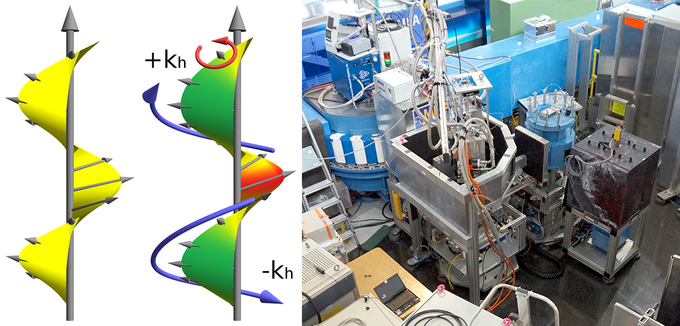Neutrons observe the dynamics of magnetic helices
2015-09-03 – News from the Physics Department

Manganese silicon is one of the preferred crystals for magnetic research: it can be manufactured as relatively large single crystals, and it is particularly suited to investigate magnetic properties. Now theoretical and experimental physicists from TU Munich, the MLZ, and the University of Cologne managed to pull off a special coup with this material.
Seen from outside, manganese silicon shows no magnetism, inside it is different. Through a special symmetry of the crystal structure a spiral structure of the magnetic moments, a magnetic helix, is formed due to the classical exchange interaction in magnets. The pitch of the spiral is much longer than the typical distance between two atomic layers of the crystal lattice.
By neutron scattering, TUM scientists have now observed excitations of this helix. Theorists of the University of Cologne had already predicted several of these excitations, which can be identified by a longitudinal vibration and two torsional vibrations on the spiral. However, these dynamics could not be proved experimentally. Now at the Physics Department of TUM these excitations have been measured with microwaves and at the MLZ with neutrons. The MLZ scientists Max Kugler and Georg Brandl, who graduate with these experiments and the instrument scientists Robert Georgii and Klaus Seemann have modified the instrument MIRA the FRM II in a way that allows performing three-axis measurements and thus to detect the excitations of the helical magnetic structure.
The theorists have already established a mathematical model that describes these vibrations for all helical magnets. It contains only simple measurable material parameters. In the future, it is therefore possible to determine the oscillations of the magnetic moments of a helical crystal purely by calculus and without applying expensive neutron scattering techniques. The model requires only a few parameters that can be measured with a simple magnetometer in every lab and are then entered into the formula.
Robert Georgii is enthusiastic about the experiment: “This is a wonderful example of the success of basic research! However, I’ve rarely seen an experiment that works right away and has delivered such unequivocal results, which in turn is due to the close collaboration between theory and experiment.”
- Desk
- Christine Kortenbruck (FRM II), Dr. Johannes Wiedersich (Physik-Department)
Publications
- Band structure of helimagnons in MnSi resolved by inelastic neutron scatteringM. Kugler, G. Brandl, J. Waizner, M. Janoschek, R. Georgii, A. Bauer, K. Seemann, A. Rosch, C. Pfleiderer, P. Böni, and M. Garst
- Universal helimagnon and skyrmion excitations in metallic, semiconducting and insulating chiral magnetsT. Schwarze, J. Waizner, M. Garst, A. Bauer, I. Stasinopoulos, H. Berger, C. Pfleiderer and D. Grundler
Contact
- Prof. Dr. Peter Böni
- Technische Universität MünchenJames-Franck-Str. 185748 GarchingTel.: +49 89 289-14711E-Mail: peter.boeni@tum.de